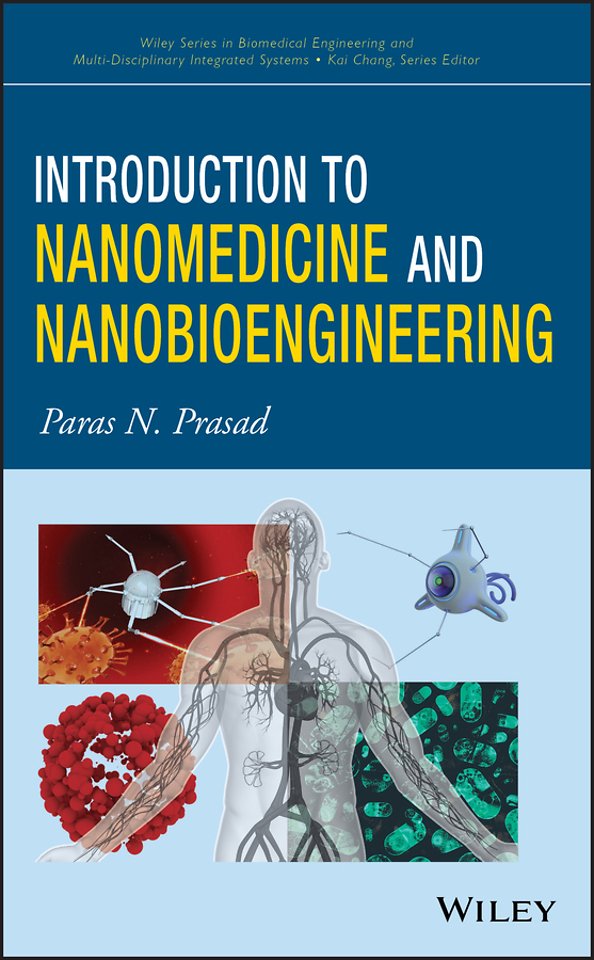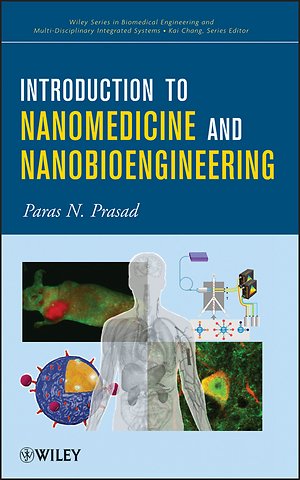Introduction to Nanomedicine and Nanobioengineering
Samenvatting
This book is an introduction to the emerging field of nanomedicine and its applications to health care. It describes the many multidisciplinary challenges facing nanomedicine and discusses the required collaboration between chemists, physicists, engineers and clinicians. The book introduces the reader to nanomedicine′s vast potential to improve and extend human life through the application of nanomaterials in diagnosis and treatment of disease.
Specificaties
Inhoudsopgave
<p>ACKNOWLEDGMENTS xv</p>
<p>1 INTRODUCTION 1</p>
<p>1.1. Nanomedicine: A Global Vision 1</p>
<p>1.2. The Nanotechnology Revolution: Realization of Asimov′s Fiction 3</p>
<p>1.3. Nanomedicine: A New Era in Personalized Medicine 7</p>
<p>1.4. Nanomedicine: A Promise or Reality? 9</p>
<p>1.5. A New Frontier: Multidisciplinary Challenges and Opportunities 10</p>
<p>1.6. Scope of the Book: Multidisciplinary Education, Training, and Research 12</p>
<p>2 THE HUMAN BODY 15</p>
<p>2.1. Introductory Concepts 16</p>
<p>2.2. Cellular Structure 18</p>
<p>2.3. Various Types of Cells 23</p>
<p>2.4. Biochemical Makeup of Cells 25</p>
<p>2.5. Other Important Cellular Components 29</p>
<p>2.6. Cellular Processes 30</p>
<p>2.7. Organization of Cells into Tissues 37</p>
<p>2.8. Types of Tissues and Their Functions 39</p>
<p>2.9. Various Organs and Organ Systems in the Body 40</p>
<p>2.10. Tumors and Cancers 45</p>
<p>3 NANOCARRIERS 51</p>
<p>3.1. Nanocarriers: Delivering Payloads to Needed Sites 52</p>
<p>3.2. The Various Nanoformulations for Nanomedicine 53</p>
<p>3.3. Viruses as Nanocarriers 55</p>
<p>3.4. Polymeric Nanocarriers 56</p>
<p>3.5. Lipid–Based Nanocarriers 58</p>
<p>3.6. Dendrimers 59</p>
<p>3.7. Carbon Nanostructures 61</p>
<p>3.8. Inorganic Nanoparticles 63</p>
<p>3.9. PEBBLE 65</p>
<p>3.10. Nanoclinics 66</p>
<p>3.11. Nanoplexes 68</p>
<p>3.12. New–Generation Nanocarriers 69</p>
<p>4 NANOCHEMISTRY OF NANOCARRIERS 77</p>
<p>4.1. Nanochemistry and Nanomedicine 78</p>
<p>4.2. Top–Down Approaches 78</p>
<p>4.3. Bottom–Up Approaches 83</p>
<p>4.4. Combination of Bottom–Up and Top–Down Approaches 92</p>
<p>4.5. Nanoparticle Surface Modification 93</p>
<p>4.6. Functionalization and Bioconjugation 95</p>
<p>5 MULTIFUNCTIONALITIES FOR DIAGNOSTICS AND THERAPY 103</p>
<p>5.1. The Various Functionalities 104</p>
<p>5.2. Optical Functionalities 105</p>
<p>5.3. Optical Nanoprobes 110</p>
<p>5.4. Magnetic Functionality 116</p>
<p>5.5. Thermal Functionality 120</p>
<p>5.6. Radioactive Functionality 121</p>
<p>5.7. Biological Functionality 124</p>
<p>5.8. Multifunctionality 125</p>
<p>6 CROSSING THE BIOLOGICAL BARRIERS 135</p>
<p>6.1. Various Delivery Pathways 135</p>
<p>6.2. Various Biological Barriers 137</p>
<p>6.3. Stealth Nanoparticles 140</p>
<p>6.4. The Various In Vitro Barrier Models 141</p>
<p>7 BIOTARGETING 149</p>
<p>7.1. Biotargeting: Why We Need It 149</p>
<p>7.2. Targeted Biological Sites 150</p>
<p>7.3. Intracellular Uptake 151</p>
<p>7.4. Targeting Strategies 153</p>
<p>7.5. Targeting Groups 155</p>
<p>8 MULTIMODAL BIOMEDICAL IMAGING 163</p>
<p>8.1. Biomedical Imaging Techniques 164</p>
<p>8.2. Optical Bioimaging 170</p>
<p>8.3. Magnetic Resonance Imaging 185</p>
<p>8.4. X–Ray CT Imaging 188</p>
<p>8.5. Radio Imaging 190</p>
<p>8.6. Ultrasound Imaging 190</p>
<p>8.7. Photoacoustic Imaging 191</p>
<p>8.8. Multimodal Imaging 192</p>
<p>9 BIOSENSING 207</p>
<p>9.1. Principles of Biosensing 208</p>
<p>9.2. Optical Biosensors 211</p>
<p>9.3. Magnetic Biosensors 228</p>
<p>9.4. Electrical Biosensing 234</p>
<p>9.5. Electrochemical Biosensing 236</p>
<p>9.6. Electrochemiluminescence Biosensing 238</p>
<p>9.7. In Vivo Bioelectronic Sensors 239</p>
<p>10 HIGH–THROUGHPUT MULTIPLEXED DIAGNOSTICS 253</p>
<p>10.1. Comprehensive Diagnostic Strategy 254</p>
<p>10.2. Flow Cytometry 255</p>
<p>10.3. Enzyme–Linked Immunosorbent Assay (ELISA) 264</p>
<p>10.4. Microarrays Technology 269</p>
<p>10.5. Suspension Bead Assay 277</p>
<p>11 NANOPHARMACOTHERAPY 291</p>
<p>11.1. Nanopharmacotherapy: An Overview 292</p>
<p>11.2. Modes of Nanoformulation for Nanopharmacotherapy 294</p>
<p>11.3. Pharmacokinetics 296</p>
<p>11.4. Biodistribution 297</p>
<p>11.5. Pharmacodynamics 298</p>
<p>11.6. Controlled Release by External Activation 299</p>
<p>12 THE HUMAN CIRCULATORY SYSTEM AND THERANOSTICS 305</p>
<p>12.1. Blood Fluidics and Cardiovascular System 306</p>
<p>12.2. Circulatory–System–Based Disease Profiling 309</p>
<p>12.3. Methods to Monitor Blood Flow 312</p>
<p>12.4. Therapeutic Approaches Utilizing Manipulation of Blood Flow 318</p>
<p>12.5. Lymph Node Mapping 320</p>
<p>12.6. Lymphatic Drug Delivery 322</p>
<p>13 NANOTECHNOLOGY FOR CANCER 331</p>
<p>13.1. Benefits of Cancer Nanotechnology 332</p>
<p>13.2. Chemotherapy 335<br /><br />13.3. Cancer Gene Therapy 339</p>
<p>13.4. Photodynamic Therapy 340</p>
<p>13.5. Magnetic Therapy 349</p>
<p>13.6. Photothermal Therapy 353</p>
<p>13.7. Neutron Capture Therapy 357</p>
<p>13.8. Circulating Tumor Cells 359</p>
<p>13.9. NCI Alliance for Cancer Nanotechnology 360</p>
<p>14 GENE THERAPY 371</p>
<p>14.1. The Principles, Steps, and Impact of Gene Therapy 372</p>
<p>14.2. Methods of Gene Delivery 374</p>
<p>14.3. Gene Augmentation Therapy 381</p>
<p>14.4. Gene Silencing Therapy 381</p>
<p>14.5. Indirect Gene Therapy Modulating Innate Immune Response 384</p>
<p>14.6. Transmucosal Gene Delivery 385</p>
<p>15 NANOTECHNOLOGY FOR INFECTIOUS DISEASES 393</p>
<p>15.1. Pathogen Infections and Nanoparticle–Based Approaches 394</p>
<p>15.2. HIV 401</p>
<p>15.3. Influenza 408</p>
<p>15.4. Tuberculosis 410</p>
<p>15.5. Malaria 416</p>
<p>16 REJUVENATION THERAPY 433</p>
<p>16.1. Rejuvenation Therapy: Fantasy or Reality? 433</p>
<p>16.2. Free Radical Scavenging 436</p>
<p>16.3. Chelation Therapy 439</p>
<p>16.4. Hormone Therapy 441</p>
<p>17 STEM CELL BIOTECHNOLOGY 447</p>
<p>17.1. Stem Cell Biotechnology: Overview 448</p>
<p>17.2. Cell Reprogramming 449</p>
<p>17.3. Gene Transfection 452</p>
<p>17.4. Somatic Cell Transdifferentiation 453</p>
<p>17.5. Stem Cell Sorting 454</p>
<p>17.6. Stem Cell Tracking 454</p>
<p>18 TISSUE ENGINEERING 461</p>
<p>18.1. Tissue Engineering: Overview 462</p>
<p>18.2. Tissue Regeneration 464</p>
<p>18.3. Nanotechnology in Tissue Engineering 467</p>
<p>18.4. Nanofibers for Tissue Engineering 472</p>
<p>18.5. Nanoparticle Delivery of Biomolecules 473</p>
<p>18.6. Magnetically Assisted Tissue Engineering 474</p>
<p>18.7. Tissue/Organ Printing 475</p>
<p>18.8. Tissue Bonding 477</p>
<p>19 NANODERMATOLOGY AND NANOCOSMETICS 487</p>
<p>19.1. Delivery Through Skin 487</p>
<p>19.2. Skin Care and Nanotechnology 488</p>
<p>19.3. Various Nanoparticles for Dermatology and Cosmetics 491</p>
<p>19.4. Nanodermatology 492</p>
<p>19.5. Nanocosmetics 494</p>
<p>19.6. Nanotoxicology of the Skin 497</p>
<p>20 NANODENTISTRY 503</p>
<p>20.1. Nanotechnology for Dental Care 504</p>
<p>20.2. Nanoparticles for Preventive Dentistry 507</p>
<p>20.3. Nanomaterials for Restorative Dentistry 509</p>
<p>20.4. Regenerative Dentistry 516</p>
<p>20.5. Nanoparticle–Enhanced Dental Imaging and Oral Diagnostics 519</p>
<p>20.6. Nanorobotics for Dentistry 522</p>
<p>21 NANOTOXICITY 529</p>
<p>21.1. Toxicity of Nanoparticles 529</p>
<p>21.2. Cytotoxicity 533</p>
<p>21.3. In Vitro Cytotoxicity Assays 535<br /><br />21.4. In Vivo Toxicity 539</p>
<p>21.5. In Vivo Toxicity Evaluation 542</p>
<p>21.6. Nanotoxicity Studies on Selected Nanoparticles 542</p>
<p>Highlights of the Chapter 547</p>
<p>Exercises 550</p>
<p>References 551</p>
<p>INDEX 555</p>

